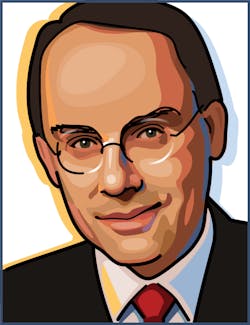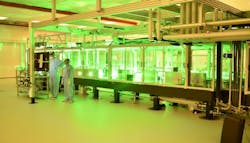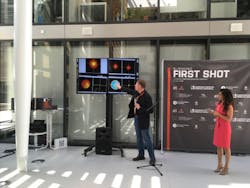
A workhorse has been inaugurated on July 2. Its birth had been attended by the American and European laser elite. Built and developed under the Californian sun at the Lawrence Livermore National Laboratory (LLNL), it found its home in Dolni Brezany, near Prague, in the Czech Republic.
“HAPLS has found a beautiful home here,” said Bill Goldstein, Director of LLNL, in his speech at the celebration. Its name HAPLS stands for High-Repetition-Rate Advanced Petawatt Laser System, locals often call it just L3 as it will be the third laser system at the Extreme Light Infrastructure Beamline facility (ELI BL).
ELI BL will be run by the Institute of Physics of the Czech Academy of Science just as LLNL is run by the University of California. ELI BL is the largest single science investment in the Czech Republic and so the inauguration of that new laser was attended by the President of the Czech Academy of Science Eva Zažímalová, and Deputy Minister for Research and Higher Education Pavel Dolecek, plus a number of American and Czech officials.
The new institute has been constructed and equipped according to the best understanding of laser technology today. “After touring this marvelous facility I was ready to quit my day job and join the lab here,” confided Kim Budil good naturedly. Within the University of California Office of the President she oversees the National Laboratories.
And… L3 is on time and on budget.
HAPLS enables closed-loop optimization
Recently, LLNL published an overview on where HAPLS stands today: The system has been tested at its first operation point of 16 joules and 27 fs pulse duration at 3.3 Hz repetition rate, equivalent to a peak power of approximately 0.5 petawatt after the pulse compressor. The final design specifications are 10 Hz, 30 J, and less than 30 fs pulse length leading to 1 petawatt of peak power. Ramp up to full power is planned for the next months with first experiments starting in October 2018.Constantin Haefner, Director of the Advanced Photon Technologies Program, oversaw the HALPS project at LLNL. He said: “ELI Beamlines has been leaning forward to build a facility that is visionary and competitive for years to come.” Comparing it with the first petawatt laser at LLNL from 1996 he sees a 200,000 times advancement in speed. For the first time it will enable petawatt science with closed loop optimization of the laser and the experiment.
Plenty of projects for the workhorse
There are many experiments planned, most of them will use L3 as a source for secondary radiation of X-rays, electrons, and protons, as Georg Korn, Scientific, Director at ELI BL, explained in his presentation of application plans. Proton beams, for instance, will be applied for a variety of medical experiments. The main directions are fundamental research, biomedical applications, and material science. Projects for the far future could also include a laser-driven neutron source for nondestructive testing.
Particle acceleration will be one important field of research. With 10 Hz repetition rate, HAPLS approaches the parameters of conventional particle accelerators on a much smaller footprint. For comparison: The European X-FEL in Hamburg has a length of about 3 km, whereas a laser-driven FEL as developed by ELI BL, DESY, and University of Hamburg will have a length of approximately 30 m. With this Laser Undulator X-Ray source (LUX) they target 106 photons/shot and later on—with SASE amplification—even 1011 photons per shot from a 12 m undulator.
And there is more to come!
Todd Ditmire from University of Texas at Austin is working hard to deliver the next workhorse for ELI BL. At the L3-inauguration he represented a consortium of National Energetics (prime contractor), Ekspla, LLNL, and Schott.
In the picture of workhorses, his laser is more kind of a Shire horse. 500 Joule pulse energy is the milestone that Todd Ditmire has reached already, tests with 1000 J run this week. It is designed to fire once per minute, which is still fast for such a giant system with a target power of 10 PW.
According to Ditmire, the main L4 system at full energy without the compressor will be shipped to Prague this September from Austin. It will be reassembled by a joint team from NE, Ekspla, and ELI BL with the goal of kJ operation before Christmas 2018. The compressor components will be delivered to ELI mid-2019 with the goal of 10 PW operation (1.4 kJ in 140 fs) by Fall 2019.
Funding secured, doors open for partners
The whole ELI project became possible through generous funding by the European Commission through infrastructural funds (85%) and matching funds from the local governments (15%). This program ends in 2018. While ELI establishes itself as a user facility, the Czech government assured another 2 years support at 20 million euros per year. The upgrade project ADONIS (Advanced research using high intensity laser produced photons and particles) runs until October 2022 and adds another 50 million euros. Further projects with budgets of two-digit millions are pending, as Georg Korn confirmed to me.In particular he wanted to point to special funding of excellent research groups: The HIFI group led by Sergey Bulanov and the ELIBIO team led by Janos Hajdu receive another 9 million euros over the next 4 years of the Support to Excellent Research Teams Program from the Czech government.
So the basic funding seems secure. Nevertheless, new partners are invited to join the ELI consortium. And this invitation is not limited to Europe—the American partners were cordially invited to join at the inauguration ceremony. A first formal call for HAPLS experiments will be issued later this year.
Related: ELI aims to break down the vacuum, a 2011 article describing the project by contributing editor Jeff Hecht
Related: High-energy Lasers: Extreme light in zeptoseconds, a 2016 article by Gerard Mourou, Toshiki Tajima, and Jonathan Wheeler explaining advances in extreme light sources
Related: The Extreme Light Infrastructure takes off, a 2017 article on recent progress at the Hungarian facility ELI ALPS by contributing editor Andreas Thoss

Andreas Thoss | Contributing Editor, Germany
Andreas Thoss is the Managing Director of THOSS Media (Berlin) and has many years of experience in photonics-related research, publishing, marketing, and public relations. He worked with John Wiley & Sons until 2010, when he founded THOSS Media. In 2012, he founded the scientific journal Advanced Optical Technologies. His university research focused on ultrashort and ultra-intense laser pulses, and he holds several patents.

